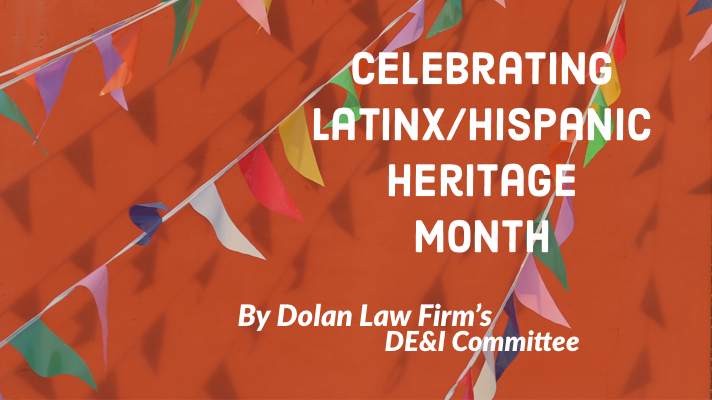Celebrating Latinx/Hispanic Heritage Month By the Dolan Law Firm DE&I Committee
In honor of Latinx/Hispanic Heritage Month, which is celebrated from September 15 to October 15, the Dolan Law Firm celebrates the culture of both Hispanic and Latinx individuals and communities.
Background
“Hispanic Heritage Month” began as a weeklong celebration coined as “Hispanic Heritage Week” in 1968. President Lyndon Johnson signed the National Hispanic Heritage Week Bill (P.L. 90-498) and was eventually enacted into law on August 17, 1988 (law-100-402) by President Ronald Reagan who extended the week to a full 31 days.
Additional Important Dates
- September 15 marks the independence day for various Latin countries, primarily from Central America: Costa Rica, El Salvador, Guatemala, Honduras and Nicaragua.
- September 16 is Mexico’s independence Day.
- September 18 is Chile’s Independence Day.
- The second Monday of October (October 11th this year) was originally observed as Christopher Columbus Day. However, many have rejected the commemoration of Columbus and have pushed for the holiday to be renamed to celebrate the unique and often indigenous ancestry of Latinx people. Many communities of color and officially recognized by cities and states across the U.S. celebrate Indigenous Peoples’ Day. Some Latin American cultures celebrate Dia de la Raza, Day of the Race or Day of Hispanic Heritage. Latinx/Hispanic Heritage Month is an opportunity to highlight and celebrate the rich contributions and diverse makeup of Latin American culture.
Debate on the term Hispanic or Latinx?
The term Latinx is originated in “activist circles primarily in the U.S. as an expansion of earlier gender-inclusive variations such as Latino/a and Latin@”. The “x”does not imply a specific gender – as would the “o” (masculine) or “a” (feminine) for nouns in Spanish and is meant to disrupt the grammatical binary that is inherent in this romance language” according to Joseph M. Pierce, an assistant professor in the Department of Hispanic Languages & Literature at Stony Brook University.
The difference between Latinx and Hispanic largely comes down to how you self-identify. Latinx has been adopted among people who are looking for a more gender-free alternative to Latino or Latina (leaving no option for those who choose to identify as non-binary).
Honoring Historical Events and Contributions Made by People of Hispanic/Latino Heritage
- Color TV – Guillermo Gonzalez Camarena, only 23-years-old, patented a chronoscope adapter with which black and white cameras of the day could capture color. NASA used the mechanism as recently as 1979 to transmit images of Jupiter.
- Mendez v. Westminster – In 1946, eight years before Brown v. Board of Education, Mexican Americans in Orange County California won a class action lawsuit to dismantle the segregated school system. Federal District Judge Paul McCormick, delivered a landmark ruling that segregation of Mexican Americans was not only unenforceable under California law, but it violated the equal protection clause of the 14th Amendment to the U.S. Constitution.
- Helen Rodriguez Trias – Headed the department of pediatrics at Lincoln Hospital in the South Bronx. In 1970 she was a founding member of the Committee to End Sterilization abuse and in 1971 a founding member of the Women’s Caucus of the American Public Health Association. She supported abortion rights, fought for the abolishment of enforced sterilization and sought neonatal care for underserved people. She drafted guidelines requiring a woman’s written consent to sterilization in a language they could understand and set a waiting period between the consent and the sterilization procedure. She is credited with helping to expand the range of public health services for women and children in minority and low-income populations in the United States, Central and South America, Africa, Asia, and the Middle East.
- Astronaut Ellen Ochoa became the first Latina to go to space in 1993. She served on a nine-day mission aboard the space shuttle Discovery where she studied the Earth’s ozone layer, then returned to space three more times, spending nearly 1,000 hours in orbit. Ochoa was honored with NASA’s distinguished Service Medal and served as the director of the Johnson Space Center in Houston Texas, from 2013 to 2018. In 2017, she was inducted to the United States Astronaut Hall of Fame and in 2018 she was inducted into the 2018 International Air and Space Hall of Fame class.
- Sonia Sotomayor – Became the first Latina Supreme Court Justice and the third woman to serve on the court. She ruled in the majority which upheld the Affordable Care Act twice, and in Obergefell v. Hodges, to legalize same-sex marriage in all 50 states.









